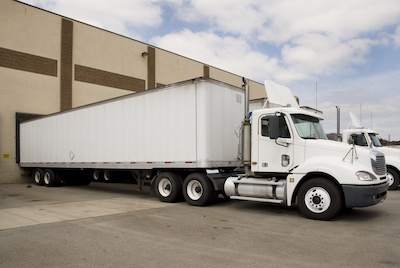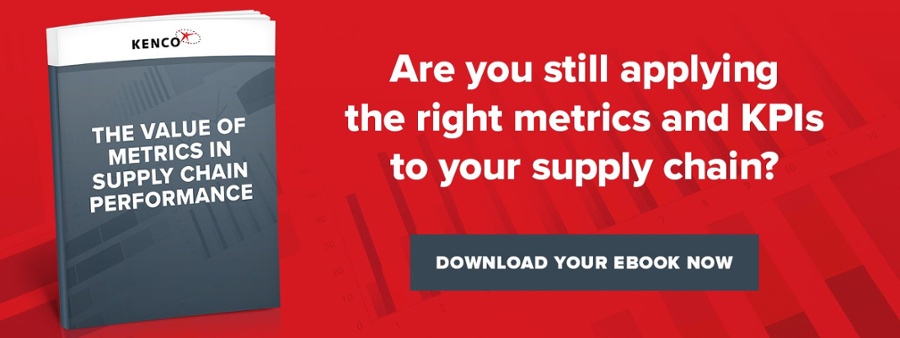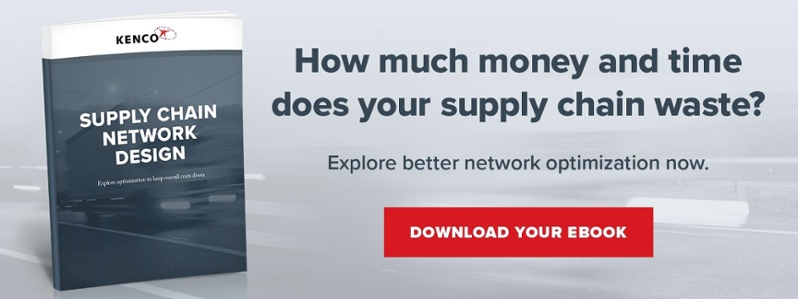The supply chain is one of the most commonly discussed aspects of business––so much so that it seems to take on a life of its own. At its core, however, the supply chain amounts to a series of decisions: which route to take, which method to use, which vendor to partner with, and so on.
This means adjusting physical objects can't guarantee lasting cost savings; a good decision needs to touch the source of those objects and address the root of the problem, not the symptoms. Without this systemic approach, you're only pruning the very tips of your network "branches." Any effect will be temporary and small in the grand scheme of your operations.
Believe it or not, there's really only one foolproof way to lower costs in the supply chain: introducing more efficiency into the network.
 Industry news source, Logistics Management, points out many companies have a supply chain that is so "piled high" with points of contact, they end up overwhelmed and misinformed before they can even design an approach for efficiency improvement.
Industry news source, Logistics Management, points out many companies have a supply chain that is so "piled high" with points of contact, they end up overwhelmed and misinformed before they can even design an approach for efficiency improvement.
Is your company guilty of a similar misstep? If these problems sound familiar, you're in luck: you've found a valuable resource in our 2018 guide to supply chain network design.
Today, we'll talk about a few key things:
- The 3 steps your company will need to take to be in the best possible mindset for taking on network optimization.
- The key costs associated with your current supply chain network design.
- A few essential steps for forward-thinking network design optimization.
- Supply chain trends the experts are focusing on in 2018.
- And lastly, sustainability in modern supply chain networks.
Let's get started by establishing a positive mindset to examining your current supply chain.
Step One: Accept That the Supply Chain Has Evolved
It sounds like an oversimplification, but the larger and/or older your business, the more likely your supply chain is mired in legacy tactics, technology, or philosophy. Call it supply chain entropy, but when change means cost and discomfort, it's hard to sell change to the C-suite.
Thus, the same suppliers and routes remain, and costs continue to creep up year after year, unchecked.
While this stagnation would be troublesome all by itself, the incredible rate of evolution in business compounds the issue. This leaves formerly successful businesses stumbling when it comes to concepts like omnichannel sales, but that doesn't have to happen if we direct our attention to supply chain design.
Step Two: Think Outside the Literal Box
The "box" in this case doesn't represent short-sighted thinking. It refers to the four walls of your warehouse.
Often an unintentional boundary for solutions, the walls of your storage facility are only a small part of the overall workflow; facets like supplier relationships and even inbound shipping methods all have the power to alter expenses in either direction. In some cases even making or breaking a budget.
Smart supply chain network design embraces a holistic view of the supply chain, taking into account the opportunities (and potential shortfalls) of every node, every package handoff, and every waiting period before making decisions.
CSCMP's Supply Chain Quarterly highlights the need for versatility in warehousing itself, explaining non-traditional warehousing can be viewed as a tool which radically shifts the supply chain for the better. Smaller warehouses, specialty shared storage areas and even purely digital "warehouses" for digital goods can all drive down costs while providing product longevity and ease-of-access.
Step Three: Remember the Heart of Your Supply Chain
Whether your main focus is in B2C or B2B, it's absolutely crucial to remember that customer service is the most important product you'll ever stock. When you design your supply chain network with your end client or customer in mind, you'll end up succeeding by default.
Repeat orders and positive word of mouth buoy your future brand-building efforts!
Bear in mind this customer-centric focus isn't only about attitude, it's about features: something as small as consciously partnering with a vendor that offers automated data feeds can make a huge difference, for example.
When your vendor offers product or shipment data automatically, that in turn allows you to share the feed with your customers and promote transparency. UPS recently emphasized this digital feed focus as an absolute need for companies of all industries in 2018, citing increased consumer demands for data and transparency in ordering experiences.
The Costs Associated with Supply Chain Network Design
 The three main areas you'll have to research to reduce costs while supporting efficiency are blissfully simple: transportation, carrying costs, and facility (distribution center) expenses. Transportation encompasses both incoming and outgoing shipments, product costs include product lifespan and viability, and facility expenses include your in-warehouse workforce and how diligently they're protecting your business.
The three main areas you'll have to research to reduce costs while supporting efficiency are blissfully simple: transportation, carrying costs, and facility (distribution center) expenses. Transportation encompasses both incoming and outgoing shipments, product costs include product lifespan and viability, and facility expenses include your in-warehouse workforce and how diligently they're protecting your business.
We covered these three cost areas in-depth in another post on the Kenco blog:
"Transportation costs: Leading off, transportation costs are typically the biggest contributor related to getting product to your customers. According to the 2014 26th Annual State of Logistics, the trucking industry reached nearly 100% of capacity, with rail to air freight approaching similar restraints. The capacity reached and rising costs (3.6% in 2014) help to show how optimization is the only way to reduce transportation costs.
Inventory carrying costs: Optimizing your inventory reduces variability. Avoid any surprises or variations by making sure inventory is stored and replenished in cost-effective and consistent cycles. Take into account demand variability, service level requirements, and cycle times associated with manufacturing and transport to calculate proper safety stock levels. Keep it at the lowest possible (though safe) levels to avoid unnecessary warehousing costs. You'll need to find the balance of having the right amount of safety stock without having so much that you waste space and resources.
Distribution center operating costs: Warehousing costs make up an estimated 30% of carrying costs—a whopping percentage of the overall cost to any 3PL organization. Minimize these costs and optimize your distribution centers to make a huge impact on the bottom line... To find your process, set a baseline of current operations. Then, split your network into two parts—one that works to cut distribution center costs and the other to emphasize service. The two sides will work against each other, and that is the point. Find the compromise between the two for the best results."
Read the rest of the post here: Reduce These 3 Cost Areas to Optimize Your Supply Chain Network.
Essential Steps for Network Optimization:
Optimizing should always start at the beginning: where are your raw materials or components coming in? If you're sourcing domestically, it's worth researching to see if a manufacturing facility is located closer than your current vendor partner's facilities.
If you're importing, consider your ports, planes, and transportation interactions overseas: are they as efficient and cost-effective as they can be?
If your needs have changed since beginning a relationship with these suppliers, perform an assessment to see if they're still a good fit. These questions will start leading you down the path to efficiency––but only if you ask them as soon as possible.
If you're already overwhelmed with keeping your businesses humming along, you'll need a trusted partner to ask these questions and act on the answers on your behalf. At Kenco, we can demand clarity for your company, and get the answers you need to start seeing some substantial cost savings. When you work with us, we'll gather the data points that matter, so you don't have to worry about them.
From there, we'll be able to offer a baseline for future business comparisons as well as smart distribution center location advice, and recommendations for ideal manufacturing speed and volume to match demand as perfectly as possible.
Learn more about how our Kenco team values metrics and data in the supply chain in our eBook, here.
2018 Supply Chain Trends:
Politics continues to be a driving force for a great deal of change––and in some cases, disruption––of international supply chains. Consider the recent tax bill signed into law by the Trump administration.
For American companies, this new law will increase cash flow and allow more investments into tools and resources to make your supply chain more efficient. However, from a global perspective, this bill has potential to disrupt business and trade with foreign companies. Importing and exporting goods to other countries could become more costly under this bill, which could ultimately harm the global supply chain.
Along with more traditional issues such as driver strikes, natural disasters, and port closures, these scenarios form the backbone of Kenco's risk analysis. Our integrated logistics services and network design features can help you weather any storm––including a "red tape tornado."
On the consumer front, customization and "last mile" shipping options continue to drive the need for specialized pick/packing. Additionally, the need for a comprehensive suite of direct-to-customer shipping methods through major carriers grows exponentially.
In other words, many businesses are finding success in thinking at the individual order level and devoting customer service time to the experience: a far cry from dusty pallets and endless look-alike storage racks. This is precisely why it's important to "think outside the warehouse" and team up with a 3PL that's "been there" so that they can guide you through this exciting (though intimidating) place of growth for your business.
Another Reason to Optimize Your Network:
Still not sure optimization will make a difference in your business costs? (Spoiler alert: it will, if only to undo any bad practices you're currently guilty of.)
If the cost-savings potential doesn't entice you, and the need to satisfy your customer isn't registering on your radar, sustainability still holds a lot of sway.

While the current administration's recent executive orders may have taken a little wind out of the proverbial solar sails, eco-friendly business practices are still here to stay. Optimizing your network in the supply chain means preemptively reducing your carbon footprint ahead of future regulatory legislation. It also gives your marketing team a solid bullet point to incorporate when discussing your brand's ethics.
If hard work is the engine that drives your business, think of supply chain network design as the oil that keeps all of the moving parts turning smoothly.
While you might be able to run the business without using it in the short term, your system is also going to start showing signs of wear and tear almost immediately.
Don't take the chance of your supply chain network dragging down your bottom line. Take some time to analyze your network design and call in a 3PL expert to be your advocate. Your business will run better, your vendors will be less stressed, and your customers will be happy to get their orders reliably and on time.
To Sum It All Up
If your company is in a place of change––such as a merger, DC growth, or renewing a facility lease––you may be on the proactive side of anticipating a network optimization.
But perhaps you simply feel a build-up of complacency in your supply chain as costs creep up and up. In this case, our eBook on the importance of your design will help Supply Chain Network Design. In it, you'll get an in-depth look at how our optimization team works through a project with our case study.




